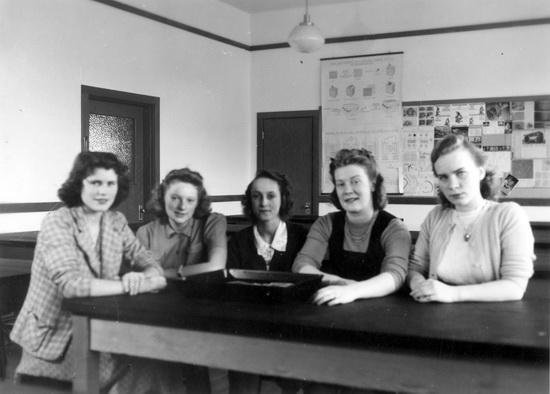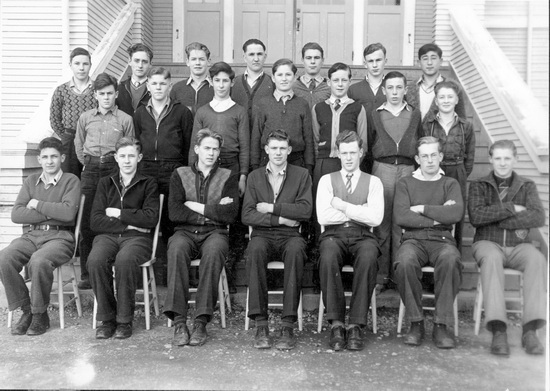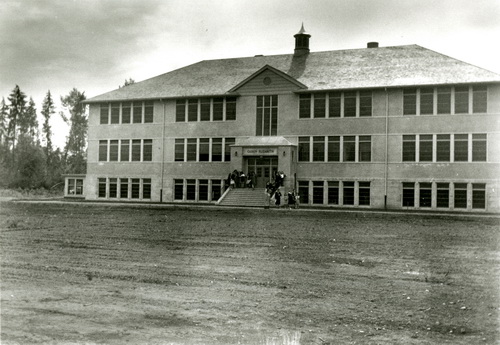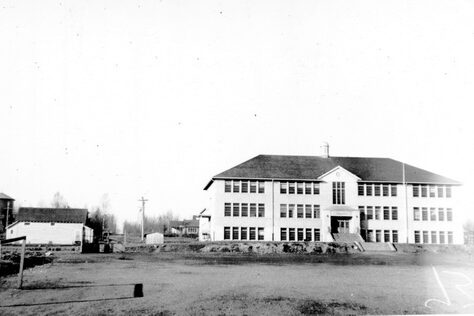Surrey’s growing population resulted in a huge increase in students, both elementary and high school. During the 1939-1940 school year many students had to be bussed to schools in New Westminster due to Surrey High School becoming extremely overcrowded, which was a great expense to council. The school was so overcrowded that they held classes anywhere they could, with one student commenting that her classroom seemed like a converted chicken coop. Students in White Rock sometimes had to cross the border and attend school in Blaine, Washington. This also extended the day for these students who had to leave much earlier in the morning and arrive later, sometimes even into the evening. Surrey then voted overwhelmingly ‘yes’ on a by-law to create two new junior-senior high schools, one elementary school and to remodel the only existing high school, Surrey High School (later renamed Lord Tweedsmuir High School). This was done to avoid the consistent spending on busses, with the hope that this one-time large expense would save money in the long run.1


Although both Queen Elizabeth High School and Semiahmoo High School were slated to open for the 1940 school year, worker strikes and the need for building materials for war purposes delayed the openings. The schools did not open until November of 1940. Many students meant to be attending these schools instead had to do their classes in elementary schools, with many high school and elementary students only attending school every other day. Often high school students had to attend school in the basement of these elementary schools. Come November and the end of school construction, all three junior-senior high schools in Surrey were now equipped with an industrial arts classroom centre, home economics classrooms, and gymnasiums.2


Accompanying the increase in student numbers was a worsening of student behavior, including vandalism. This created challenges for the schools and the school board. In 1944 student increasing “absenteeism and delinquency” proved to be a great concern of the Surrey School Board, the Surrey Council, the Surrey Police, and the Police Commission. These groups did not fully blame parents but identified them as a contributing factor to the issues at hand.3
Next Page → The War and Educational Resources
References
- 190.1.18 – Untitled, 1980-1981, F125-0-24-1-14, Box 1, File 18, Historical Manuscripts Collection: Education: Schools and Teachers, Courtesy of Surrey Archives, Surrey, BC, Canada.; “Big Majority for School By-Law in Record Turn-out.” The Surrey Leader (Surrey, BC, Canada), April 24, 1940. Accessed through Surrey Archives.; Joan Parolin (nee Gillis) Interview, 8 Aug. 1990. SMA90.21.19. Surrey Museum and Archives Oral History Collection. Courtesy of Surrey Archives, Surrey, BC. Canada.; Letter to the editor from R. H. Reed. The Surrey Leader (Surrey, BC, Canada), October 25, 1939. Accessed through Surrey Archives.; “School Grant of $2500 Given for Local Emergency.” The Surrey Leader (Surrey, BC, Canada), September 27, 1939. Accessed through Surrey Archives. ↩︎
- 190.1.18 – Untitled.; “High Schools Ready Nov. 1.” The Surrey Leader (Surrey, BC, Canada), August 21, 1940. Accessed through Surrey Archives.; “Lathers Strike Again Delays School Opening.” The Surrey Leader (Surrey, BC, Canada), October 16, 1940. Accessed through Surrey Archives.; “New Schools are Modern Throughout; Accommodation Unique in All Building Detail.” The Surrey Leader (Surrey, BC, Canada), November 27, 1940. Accessed through Surrey Archives. ↩︎
- “Authorities Discuss Juvenile Delinquency.” The Surrey Leader (Surrey, BC, Canada), May 31, 1944. Accessed through Surrey Archives. ↩︎